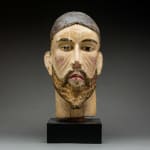Portuguese Style Wooden Head of Christ, 1600 CE - 1800 CE
Wood, Gesso
34.3 x 19.1 cm
13 1/2 x 7 1/2 in
13 1/2 x 7 1/2 in
LO.881
Further images
Carved out of solid wood, covered in gesso and painted in semi-naturalistic way, this head may represent Christ during the Passion. The elongated head with pale complexion, terminating in a...
Carved out of solid wood, covered in gesso and painted in semi-naturalistic way, this head may represent Christ during the Passion. The elongated head with pale complexion, terminating in a long beard, the front and cheeks stained with sanguine red tears, the eyes open and the mouth sealed in a severe expression of pain.
This head belonged to a small group, now gathered in the Barakat collection (see LO.882 and LO.883), discovered in a sealed room in the cellar of an Anglican church in the city of Colombo in Ceylon, in 1998, when engineers were underpinning the foundations. The church originally belonged to the Catholic Portuguese, and was passed over to the Dutch Reformists in the first quarter of the 18th century.
The style of the head would seem to place it just prior to the Dutch conquest. During the 16th and 17th centuries the practice of keeping the beard prevailed among the Roman Catholic clergy, especially amongst the foreign missionaries involved in the establishment of the Far Eastern Missions. This group of heads are stylistically affine to the early Jesuit and Franciscan iconography employed prevalently during the 17th century in India, after the foundation of the Catholic mission in Goa by St Francis Xavier, when not only the Christ but also saints, such as St Xavier and Thomas the Apostle, were often portrayed long-bearded.
Furthermore, towards the end of the Catholic presence in Ceylon (ended 1658) wooden heads and large saintly figures were indeed used not only as votive images in churches, but also as didactic vehicles in the Natya Nadagam (Nativity) plays, to introduce the Christian religion to the indigenous public.
This head so realistically painted still retains traces of where the thorn crown would have originally been placed, leaving no doubt on the identity of the wearer and his message.
This head belonged to a small group, now gathered in the Barakat collection (see LO.882 and LO.883), discovered in a sealed room in the cellar of an Anglican church in the city of Colombo in Ceylon, in 1998, when engineers were underpinning the foundations. The church originally belonged to the Catholic Portuguese, and was passed over to the Dutch Reformists in the first quarter of the 18th century.
The style of the head would seem to place it just prior to the Dutch conquest. During the 16th and 17th centuries the practice of keeping the beard prevailed among the Roman Catholic clergy, especially amongst the foreign missionaries involved in the establishment of the Far Eastern Missions. This group of heads are stylistically affine to the early Jesuit and Franciscan iconography employed prevalently during the 17th century in India, after the foundation of the Catholic mission in Goa by St Francis Xavier, when not only the Christ but also saints, such as St Xavier and Thomas the Apostle, were often portrayed long-bearded.
Furthermore, towards the end of the Catholic presence in Ceylon (ended 1658) wooden heads and large saintly figures were indeed used not only as votive images in churches, but also as didactic vehicles in the Natya Nadagam (Nativity) plays, to introduce the Christian religion to the indigenous public.
This head so realistically painted still retains traces of where the thorn crown would have originally been placed, leaving no doubt on the identity of the wearer and his message.











